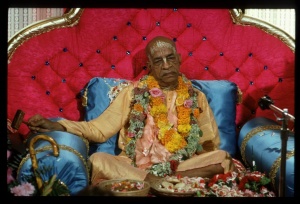CC Madhya 19.189: Difference between revisions
m (1 revision(s)) |
(Vanibot #0054 edit - transform synonyms into clickable links, which search similar occurrences) |
||
| (One intermediate revision by one other user not shown) | |||
| Line 1: | Line 1: | ||
{{ | [[Category:Sri Caitanya-caritamrta - Madhya-lila Chapter 19|C189]] | ||
<div style="float:left">'''[[Sri Caitanya-caritamrta|Śrī Caitanya-caritāmṛta]] - [[CC Madhya|Madhya-līlā]] - [[CC Madhya 19|Chapter 19: Lord Śrī Caitanya Mahāprabhu Instructs Śrīla Rūpa Gosvāmī]]'''</div> | |||
<div style="float:right">[[File:Go-previous.png|link=CC Madhya 19.188|Madhya-līlā 19.188]] '''[[CC Madhya 19.188|Madhya-līlā 19.188]] - [[CC Madhya 19.190|Madhya-līlā 19.190]]''' [[File:Go-next.png|link=CC Madhya 19.190|Madhya-līlā 19.190]]</div> | |||
{{CompareVersions|CC|Madhya 19.189|CC 1975|CC 1996}} | |||
{{RandomImage}} | |||
==== TEXT 189 ==== | ==== TEXT 189 ==== | ||
<div | <div class="verse"> | ||
śānta-bhakta—nava-yogendra, sanakādi āra | :śānta-bhakta—nava-yogendra, sanakādi āra | ||
dāsya-bhāva-bhakta—sarvatra sevaka apāra | :dāsya-bhāva-bhakta—sarvatra sevaka apāra | ||
</div> | </div> | ||
| Line 12: | Line 16: | ||
==== SYNONYMS ==== | ==== SYNONYMS ==== | ||
<div | <div class="synonyms"> | ||
śānta- | ''[//vanipedia.org/wiki/Special:VaniSearch?s=śānta&tab=syno_o&ds=1 śānta]-[//vanipedia.org/wiki/Special:VaniSearch?s=bhakta&tab=syno_o&ds=1 bhakta]'' — the neutral devotees; ''[//vanipedia.org/wiki/Special:VaniSearch?s=nava&tab=syno_o&ds=1 nava]'' — nine; ''[//vanipedia.org/wiki/Special:VaniSearch?s=yogendra&tab=syno_o&ds=1 yogendra]'' — saintly persons; ''[//vanipedia.org/wiki/Special:VaniSearch?s=sanaka&tab=syno_o&ds=1 sanaka]-[//vanipedia.org/wiki/Special:VaniSearch?s=ādi&tab=syno_o&ds=1 ādi] [//vanipedia.org/wiki/Special:VaniSearch?s=āra&tab=syno_o&ds=1 āra]'' — and the four Kumāras, headed by Sanaka; ''[//vanipedia.org/wiki/Special:VaniSearch?s=dāsya&tab=syno_o&ds=1 dāsya]-[//vanipedia.org/wiki/Special:VaniSearch?s=bhāva&tab=syno_o&ds=1 bhāva]-[//vanipedia.org/wiki/Special:VaniSearch?s=bhakta&tab=syno_o&ds=1 bhakta]'' — devotees in ''dāsya-rasa''; ''[//vanipedia.org/wiki/Special:VaniSearch?s=sarvatra&tab=syno_o&ds=1 sarvatra] [//vanipedia.org/wiki/Special:VaniSearch?s=sevaka&tab=syno_o&ds=1 sevaka] [//vanipedia.org/wiki/Special:VaniSearch?s=apāra&tab=syno_o&ds=1 apāra]'' — similar innumerable servants everywhere. | ||
</div> | </div> | ||
| Line 19: | Line 23: | ||
==== TRANSLATION ==== | ==== TRANSLATION ==== | ||
<div | <div class="translation"> | ||
“Examples of śānta-bhaktas are the nine Yogendras and the four Kumāras. Examples of devotees in dāsya-bhakti are innumerable, for such devotees exist everywhere. | “Examples of śānta-bhaktas are the nine Yogendras and the four Kumāras. Examples of devotees in dāsya-bhakti are innumerable, for such devotees exist everywhere. | ||
</div> | </div> | ||
| Line 26: | Line 30: | ||
==== PURPORT ==== | ==== PURPORT ==== | ||
<div | <div class="purport"> | ||
The nine Yogendras are Kavi, Havi, Antarīkṣa, Prabuddha, Pippalāyana, Āvirhotra, Draviḍa (Drumila), Camasa and Karabhājana. The four Kumāras are Sanaka, Sanandana, Sanat-kumāra and Sanātana. The servant devotees in Gokula are Raktaka, Citraka, Patraka and so on. In Dvārakā there are servants like Dāruka, and in the Lord’s pastimes in the material world there are servants like Hanumān. | The nine Yogendras are Kavi, Havi, Antarīkṣa, Prabuddha, Pippalāyana, Āvirhotra, Draviḍa (Drumila), Camasa and Karabhājana. The four Kumāras are Sanaka, Sanandana, Sanat-kumāra and Sanātana. The servant devotees in Gokula are Raktaka, Citraka, Patraka and so on. In Dvārakā there are servants like Dāruka, and in the Lord’s pastimes in the material world there are servants like Hanumān. | ||
</div> | </div> | ||
__NOTOC__ | |||
<div style="float:right; clear:both;">[[File:Go-previous.png|link=CC Madhya 19.188|Madhya-līlā 19.188]] '''[[CC Madhya 19.188|Madhya-līlā 19.188]] - [[CC Madhya 19.190|Madhya-līlā 19.190]]''' [[File:Go-next.png|link=CC Madhya 19.190|Madhya-līlā 19.190]]</div> | |||
__NOTOC__ | |||
__NOEDITSECTION__ | |||
Latest revision as of 22:27, 19 February 2024

A.C. Bhaktivedanta Swami Prabhupada
TEXT 189
- śānta-bhakta—nava-yogendra, sanakādi āra
- dāsya-bhāva-bhakta—sarvatra sevaka apāra
SYNONYMS
śānta-bhakta — the neutral devotees; nava — nine; yogendra — saintly persons; sanaka-ādi āra — and the four Kumāras, headed by Sanaka; dāsya-bhāva-bhakta — devotees in dāsya-rasa; sarvatra sevaka apāra — similar innumerable servants everywhere.
TRANSLATION
“Examples of śānta-bhaktas are the nine Yogendras and the four Kumāras. Examples of devotees in dāsya-bhakti are innumerable, for such devotees exist everywhere.
PURPORT
The nine Yogendras are Kavi, Havi, Antarīkṣa, Prabuddha, Pippalāyana, Āvirhotra, Draviḍa (Drumila), Camasa and Karabhājana. The four Kumāras are Sanaka, Sanandana, Sanat-kumāra and Sanātana. The servant devotees in Gokula are Raktaka, Citraka, Patraka and so on. In Dvārakā there are servants like Dāruka, and in the Lord’s pastimes in the material world there are servants like Hanumān.